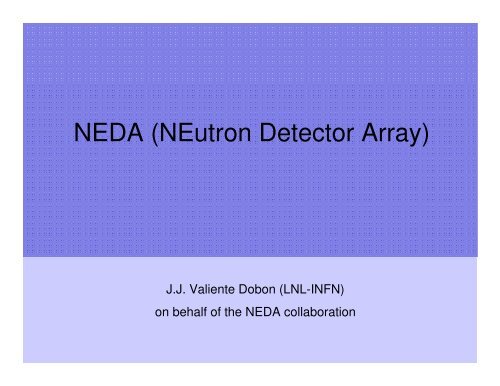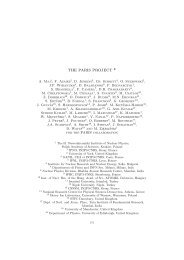NEDA (NEutron Detector Array) - Paris Collaboration Website
NEDA (NEutron Detector Array) - Paris Collaboration Website
NEDA (NEutron Detector Array) - Paris Collaboration Website
- No tags were found...
You also want an ePaper? Increase the reach of your titles
YUMPU automatically turns print PDFs into web optimized ePapers that Google loves.
OrganizationSpokeperson: J.J. Valiente Dobon (LNL-INFN)GANIL LIASON: M. Tripon (GANIL)Steering committee:-B. Wadsworth (U. Of York)-N. Erduram (U. Of Istanbul)-L. Sttugge (IRES – Strasbodurg)-J. Nyberg (U. Of Uppsala)-M. Palacz (U. Of Warsaw)-A. Gadea (IFIC - Valencia)FP7-INFRASTRUCTURES-2007-1SPIRAL2 PREPARATORY PHASE
Working groups•<strong>Detector</strong> characteristics (Report on physics of interest, this will help todefine the detector specifications).•Responsible: B. Wadsworth•Geometry (Make a full study of geometry to determine (materials)efficiency, reduce cross-talk, ... Comparison between different codes:Genat4, MCNP-X. Simulate effect of other ancillaries, neutron scattering.).•Responsible: M. Palacz•Study New Materials (Exploring new materials, solid scintillators,deuterated liquid scintillators).•Responsible: L. Stuttgé•Digital Electronics (Flash ADCs, commercial, EXOGAM-like electronics, ..)•Responsible: A. Gadea•PSA (Simulations of Pulse shapes, PSA algorithms, ...).•Responsible: J. Nyberg•Synergies other detectors (<strong>Detector</strong>s that can be considered in synergywith the new neutron wall. EXOGAM2, PARIS, AGATA, FAZIA, GASPARD,DIAMANT, DESCANT, DESPEC/HISPEC, NEUTROMANIA, ... ).•Responsible: P. Bednarczyk
Physics with <strong>NEDA</strong>• Nuclear Structure– Probe of the T=0 correlations in N=Z nuclei: The structure beyond 92 Pd(LNL, GANIL, Stockholm, York)– Coulomb Energy Differences in isobaric multiplets: T=0 versus T=1states (LNL, GANIL, York)– Coulomb Energy Differences and Nuclear Shapes (York, LNL, GANIL)– Low-lying collective modes in proton rich nuclei (Istanbul, Valencia,LNL)• Nuclear Astrophysics– Element abundances in the Inhomogeneous Big Bang Model(Weizmann, Soreq, GANIL, York collaboration)– Isospin effects on the symmetry energy and stellar collapse (Naples,Debrecen, LNL, Florence collaboration)• Nuclear Reactions– Level densities of neutron rich nuclei (Debrecen, Naples, LNL, Florencecollaboration)– Fission dynamics of neutron-rich intermediate fissility systems (Naples,Debrecen, LNL, GANIL)
Problem definition-Neutron detectors to be used coupled to AGATA/EXOGAM/PARIS and ifrequested open to do Neutron spectroscopy (energy of the neutrons).-Previous experience with the NWall (BC501)-High efficiency 30% for one neutron.-Good gamma/neutron discrimination.-Low efficiency for 2n (2-3%) or more neutrons.-Problems with cross talk
Neutron Wall: N=Z-228Si (28 Si,2nα) 50 Fe24Mg (32 S,2n) 54 NiS. Lenzi et al., PRL87, 122501 (2001)A. Gadea et al., PRL97, 152501 (2006)
Cross talk – low 2n cross sectionJ. Ljungvall et al., NIMA528 471 (2004)•High cross talk betweenneighboring detectors→ 7% all the events.•It is not possible todifferenciate between 2n realevents or just 1n scattered.•Therefore neighbouringdetectors are dismiss in theanalysis and the efficiencydecreases to 2-3%.Possible to improve 2n efficiencyusing TOF among detectorsThe aim of <strong>NEDA</strong> is to be able to distinguish between real 2nevents and scattered neutrons → Increase of the 2n efficiency.
Strategy of <strong>NEDA</strong>-Use of the TOF information in addition to the measured energy todisentangle the 1n scattered events from the real 2n channels-Use of the deuterated scintillator BC537-Pulse height proportional to incident neutron energy-Provides another method of determinig neutron energy beyondTOF-Can lead to a better discrimination of high multiplicity neutronevents and scattered events.-Possible better gamma-neutron discrimination, since moreevents are at higher energies.
BC501 vs. BC537 responseBC501BC537E n = 2.5 MeVE n = 4.3 MeVBC501ABC537Courtesy of P. Garrett University of Guelph.
Simulations ValidationNeutron HP model in G4.9.2.p01 (rel. March 2009) muchimproved comparing to earlier versionsTotal cross sections and angular distributions for elasticscattering on p, d, and 12 C reasonableCorrect (high energy) γ-ray lines producedInelastic interactions not fully validated yet.Wrong kinematics (angular distributions?) in the12C(n,α) 9 Be reaction.Important reactions still missing, like 12 C(n,n’)3αExisting defficiencies not significant in the
y Brian Roederσ(θ) elastic neutron scattering on d
Light output•The light-output L is usually given in MeVee: the particle energy requiredto generate 1 MeVee of light is defined as 1 MeV for fast electrons•L is generally less for heavier particles such as protons, deuterons,alphas, beryllium, carbon…• Therefore, the light output L in a certain path dx is a function of thedeposited energy E in dx: L(E)Deposited energyLight outputDekempeneer et Liskien NIM A 256 (1987) 489-498: NE213
Geometries•There are two possible geometries, either spherical or planar.•The spherical geometry presents the full symmetry.•The planar has some advantages, than the spherical do not present.-Flexibility – different possible arrangements of the detectors-Different focal posistions (500cm, 1000cm, 2000cm)-Budget issuesDESCANT geometry
Efficiency for the planar∆E/E=2∆t/tVersatility of the planar•2.5 mm Al encapsulation•159 mm depth•.60 side lenght.Efficiency of <strong>NEDA</strong> with 61 hexagonal detectors around 30%
Discriminating neutron/gammaPulse shapes from the detectordiffers between neutrons andgamma raysneutronsUsually both pulse shapeanalysis using analogueelectronics and the time-offlightinformation is used fordiscrimination
Digital electronics: PSAIt is possible to obtain better quality using same algorithms butdigital electronics
Digital electronics: Neural NetworkApplying an artificial neural networkcan increase the quality even furtherP=sqrt(ε n2 +ε γ2 )
MGTClocksDigital electronics: EXOGAM - <strong>NEDA</strong>M. TriponFast serial linksParallel linksSlow controlSerial linkPROM(VHDL)SeriallinkEthernet100PPCCommon LogicPCIe(Adonis)EthernetGigabitFlash (Linux)SDRAMOpticalLinkMuxGTS FaninADC Logic InterfaceDelayLineClocks(Local &Recovered)DPRAM(Physics,ADONIS)SRAM(Oscilloscope)8*FADC14 bits100MHzADC Logic- FADC samples collection- Digital Processing- Trigger- Data formatting- Inspection controlDACs(Test, control,inspection)PROM(VHDL)The basic diference EXOGAM/<strong>NEDA</strong> is the higher frequency of the ADC
Commercial electronics: Struck4 channel VME digitizer/transientrecorder with a sampling rate of upto 500 MS/s (for the individualchannel) and 12-bit resolutionProgrammable FPGAs
Avalanche PhotodiodesSPMPlusDirect replacement for photomultiplier tubeInsensitive to magnetic fieldsCan operate in vacuumLarge sizes possibleAttractive for simultaneous PET and MRI scanningGain stabilisation as function of temperature mustbe achievedSynergy with PARIS – D. Jenkins
BC501 and BC537 detectorsCurrently buying commercial detectors for tests: ELJEN, BICRON?Quartz windowELJEN technology
Summary and future work• <strong>NEDA</strong> – Looks at improving efficiency for 2n channels – BC537• Validated simulatons – realistic results for BC501 and BC537• Included light production according to latest measurements• PSA algorithms to discriminate neutron-gamma – Neural Network greatperspectives.• Synergies – PARIS: Physics and SPMPlus - EXOGAM: electronicsFUTURE WORK• Currently buying BC537 and BC501 commercial detectors to test:– cross talk– light production– PSA• Test of SPMPlus from York in BC537 and BC501 Soon?• Development of electronics and currently buying a commercial Struck digitalboard – programmable FPGA
Light output
Time scale200820092010Q4Q1Q2Q3Q4Q1Q2Q3Validation GEANT4 neutornsimulationsGeometry definitionDigital algorithms for PSA<strong>Detector</strong> prototypeTest prototypeElectronicsNegoziations MoUMoU signature
SynergiesPARISEXOGAM array





